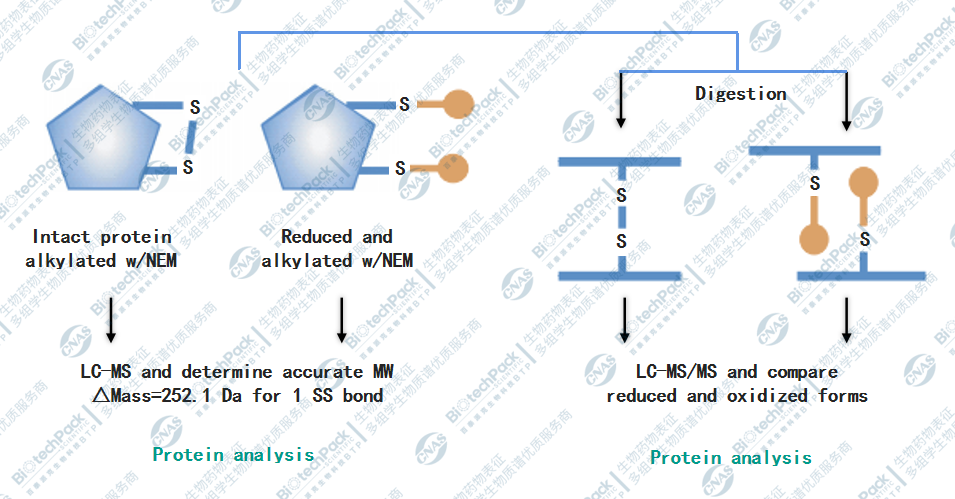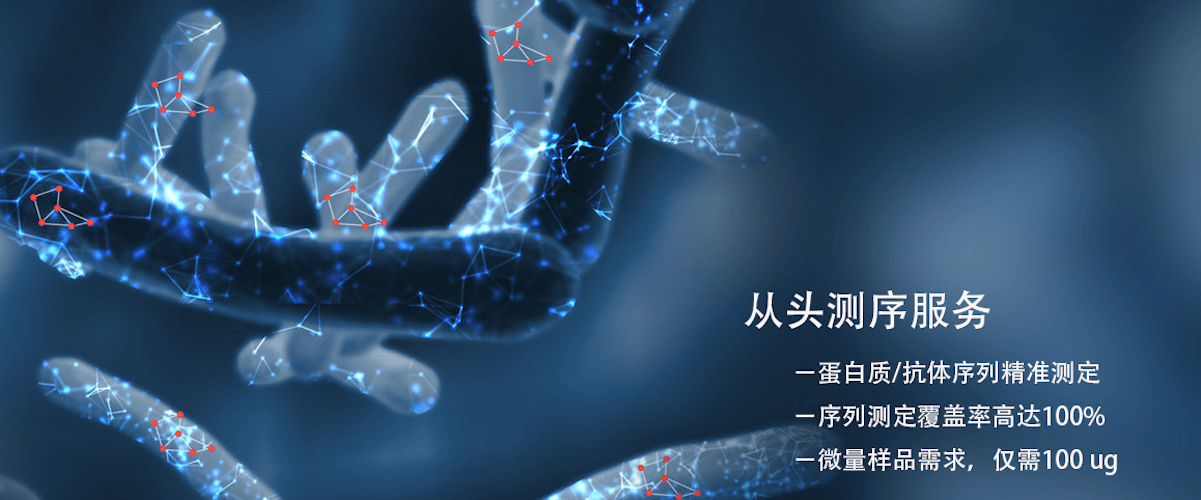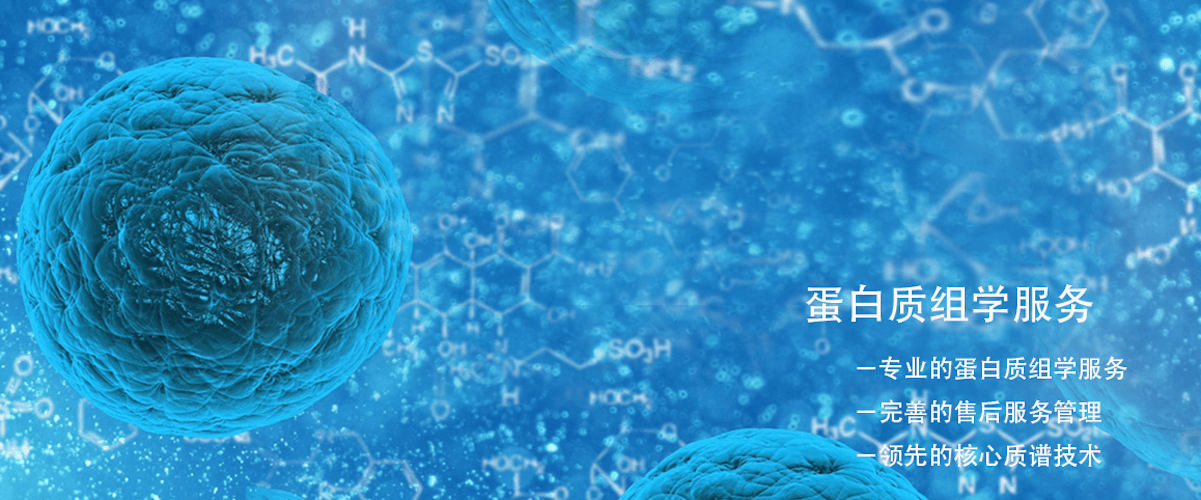Disulfide Bond Localization Analysis
Disulfide bonds are important structural units in proteins, formed by the sulfur atoms of two cysteine residues in an oxidative environment, playing a decisive role in biological activity and function. Disulfide bonds are widely present in cell surface receptors, antibodies, growth factors, hormones, enzymes, and other proteins, and are prone to reduction or mispairing, affecting the structure and biological activity of the original polypeptide or protein. Disulfide bond localization analysis, by determining the position and connection mode of disulfide bonds in protein structures, can provide an in-depth understanding of protein structure and function. In the preparation and development of biopharmaceuticals, incorrect disulfide bond pairing may lead to drug failure and even potential safety risks, so accurate detection and control of disulfide bonds are essential in the characterization of biological products.

Figure 1 Principle of Disulfide Bond Localization Analysis
The development of liquid chromatography-mass spectrometry (LC-MS) technology has greatly improved detection sensitivity and accuracy, advancing disulfide bond analysis and playing an irreplaceable role in disulfide bond localization analysis. BTP (Bio-tech Pack) is certified by CNAS/ISO9001 dual quality systems. Based on the principles of disulfide bond analysis and combined with high-performance liquid chromatography and high-resolution mass spectrometry, BTP has established a disulfide bond analysis platform to provide precise disulfide bond localization analysis services. Whether it is intra-chain/inter-chain disulfide bonds, single/multiple disulfide bonds, overlapping or mispaired disulfide bonds, BTP can perform efficient and accurate identification.Welcome to inquire for free to learn more details!
ExperimentInstrumentation
- High-Performance Liquid Chromatography: Easy-nLC 1200 (Thermo Fisher Scientific)
- High-Resolution Mass Spectrometer: Q Exactive™ Hybrid Quadrupole-Orbitrap™ Mass Spectrometer (Thermo Fisher Scientific)
Case Illustration
Disulfide bond localization using liquid chromatography-mass spectrometry does not involve reduction treatment but directly involves alkylation, a step that blocks free thiol groups. Subsequently, enzymatic digestion is performed to cut the protein molecule into small fragments. During this process, specific connections are formed between cysteines with disulfide bonds, resulting in a change in molecular weight. Next, data is collected through a mass spectrometer, and corresponding analysis software is used for database matching to obtain information on disulfide bonds.

Table 1 Disulfide Bond Analysis
Site: Position of the cysteine forming the disulfide bond in the protein; Enzyme: Enzyme used for protein digestion; Peptide: Peptide sequence; Peptide_Mass: Molecular weight of the peptide; Mass_Error(ppm): Mass deviation of the peptide

Figure 2 Peptide Secondary Structure
Frequently Asked Questions
Question 1: What are the advantages of using mass spectrometry for disulfide bond identification?
Answer:Mass spectrometry has multiple advantages in identifying disulfide bonds. Firstly, it can not only determine the presence and number of disulfide bonds but also their specific locations and relative abundances, providing more detailed information. Secondly, mass spectrometry is characterized by high sensitivity and high resolution, allowing for accurate detection and quantification of disulfide bonds, even at low concentrations. Additionally, the sample consumption required for mass spectrometry is relatively small, which is important for precious or limited samples. Therefore, mass spectrometry is widely used in disulfide bond analysis, providing strong support for studying protein structure and function.
Question 2: Why is alkylation necessary?
Answer:Alkylation is performed to block free thiol groups and prevent disulfide bond mispairing during experiments. In mass spectrometry analysis, the sample preparation process requires special handling, including an alkylation step. Alkylation involves reacting an alkylating agent with thiol groups, replacing them with alkyl groups to form alkyl thioethers. This effectively prevents reactions between thiol groups, avoiding abnormal disulfide bond connections or mispairing during experiments. Through alkylation treatment, accurate and reliable disulfide bond information can be obtained in mass spectrometry analysis, helping to reveal the structural and functional characteristics of proteins.
Bilingual Project Report in English/Chinese
In the technical report, BTP will provide you with a detailed bilingual technical report in both English and Chinese, including:
1. Experimental Procedures (in English and Chinese)
2. Relevant Mass Spectrometry Parameters (in English and Chinese)
3. Detailed Information on Disulfide Bond Localization Analysis
4. Mass Spectrometry Images
5. Raw Data
One-Stop Service for Disulfide Bond Localization Analysis
You only need to place an order and send the samples
BTP's one-stop service completes: Sample Processing - On-Machine Analysis - Data Analysis - Project Report
Related Services
Biopharmaceutical Disulfide Bond/Free Cysteine Detection
Protein Disulfide Bond Identification and Quantitative Analysis
Biopharmaceutical Glycan Mapping
Biopharmaceutical Glycosylation Site Detection
Post-Translational Modification Proteomics Analysis
Phosphorylation Quantitative Proteomics Research
Acetylation Quantitative Proteomics Research
How to order?





